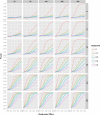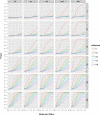Risk of bias: a simulation study of power to detect study-level moderator effects in meta-analysis
- PMID: 24286208
- PMCID: PMC4219184
- DOI: 10.1186/2046-4053-2-107
Risk of bias: a simulation study of power to detect study-level moderator effects in meta-analysis
Abstract
Background: There are both theoretical and empirical reasons to believe that design and execution factors are associated with bias in controlled trials. Statistically significant moderator effects, such as the effect of trial quality on treatment effect sizes, are rarely detected in individual meta-analyses, and evidence from meta-epidemiological datasets is inconsistent. The reasons for the disconnect between theory and empirical observation are unclear. The study objective was to explore the power to detect study level moderator effects in meta-analyses.
Methods: We generated meta-analyses using Monte-Carlo simulations and investigated the effect of number of trials, trial sample size, moderator effect size, heterogeneity, and moderator distribution on power to detect moderator effects. The simulations provide a reference guide for investigators to estimate power when planning meta-regressions.
Results: The power to detect moderator effects in meta-analyses, for example, effects of study quality on effect sizes, is largely determined by the degree of residual heterogeneity present in the dataset (noise not explained by the moderator). Larger trial sample sizes increase power only when residual heterogeneity is low. A large number of trials or low residual heterogeneity are necessary to detect effects. When the proportion of the moderator is not equal (for example, 25% 'high quality', 75% 'low quality' trials), power of 80% was rarely achieved in investigated scenarios. Application to an empirical meta-epidemiological dataset with substantial heterogeneity (I(2) = 92%, τ(2) = 0.285) estimated >200 trials are needed for a power of 80% to show a statistically significant result, even for a substantial moderator effect (0.2), and the number of trials with the less common feature (for example, few 'high quality' studies) affects power extensively.
Conclusions: Although study characteristics, such as trial quality, may explain some proportion of heterogeneity across study results in meta-analyses, residual heterogeneity is a crucial factor in determining when associations between moderator variables and effect sizes can be statistically detected. Detecting moderator effects requires more powerful analyses than are employed in most published investigations; hence negative findings should not be considered evidence of a lack of effect, and investigations are not hypothesis-proving unless power calculations show sufficient ability to detect effects.
Figures


References
-
- Torgerson DJ, Torgerson CJ. Designing Randomised Trials in Health, Education and the Social Sciences: An Introduction. 1. London: Palgrave Macmillan; 2008.
-
- Holmes R. The Age of Wonder: The Romantic Generation and the Discovery of the Beauty and Terror of Science. London: Random House Digital, Inc; 2009.
-
- Verhagen AP, de Vet HC, de Bie RA, Boers M, van den Brandt PA. The art of quality assessment of RCTs included in systematic reviews. J Clin Epidemiol. 2001;54:651–654. - PubMed
Publication types
MeSH terms
Grants and funding
LinkOut - more resources
Full Text Sources
Other Literature Sources

